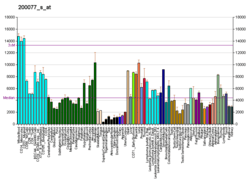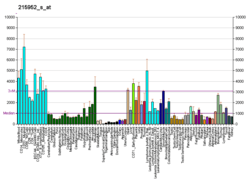OAZ1
Ornithine decarboxylase antizyme is an enzyme that in humans is encoded by the OAZ1 gene.[5][6][7]
Ornithine decarboxylase catalyzes the conversion of ornithine to putrescine in the first and apparently rate-limiting step in polyamine biosynthesis. The ornithine decarboxylase antizymes play a role in the regulation of polyamine synthesis by binding to and inhibiting ornithine decarboxylase. Antizyme expression is auto-regulated by polyamine-enhanced translational frameshifting. The antizyme encoded by this gene inhibits ornithine decarboxylase and accelerates its degradation.[7]
References
- 1 2 3 GRCh38: Ensembl release 89: ENSG00000104904 - Ensembl, May 2017
- 1 2 3 GRCm38: Ensembl release 89: ENSMUSG00000035242 - Ensembl, May 2017
- ↑ "Human PubMed Reference:".
- ↑ "Mouse PubMed Reference:".
- ↑ Tewari DS, Qian Y, Thornton RD, Pieringer J, Taub R, Mochan E, Tewari M (Feb 1995). "Molecular cloning and sequencing of a human cDNA encoding ornithine decarboxylase antizyme". Biochim Biophys Acta. 1209 (2): 293–5. doi:10.1016/0167-4838(94)90199-6. PMID 7811704.
- ↑ Matsufuji S, Inazawa J, Hayashi T, Miyazaki Y, Ichiba T, Furusaka A, Matsufuji T, Atkins JF, Gesteland RF, Murakami Y, Hayashi S (Mar 1997). "Assignment of the human antizyme gene (OAZ) to chromosome 19p13.3 by fluorescence in situ hybridization". Genomics. 38 (1): 102–104. doi:10.1006/geno.1996.0601. PMID 8954789.
- 1 2 "Entrez Gene: OAZ1 ornithine decarboxylase antizyme 1".
Further reading
- Coffino P (2000). "Polyamines in spermiogenesis: not now, darling". Proc. Natl. Acad. Sci. U.S.A. 97 (9): 4421–4423. doi:10.1073/pnas.97.9.4421. PMC 34313. PMID 10781034.
- Savage RE, Nofzinger K, Bedell C, et al. (1989). "Chloroform-induced multiple forms of ornithine decarboxylase: differential sensitivity of forms to enhancement by diethyl maleate and inhibition by ODC-antizyme". Journal of toxicology and environmental health. 27 (1): 57–64. doi:10.1080/15287398909531278. PMID 2724368.
- Matsufuji S, Matsufuji T, Miyazaki Y, et al. (1995). "Autoregulatory frameshifting in decoding mammalian ornithine decarboxylase antizyme". Cell. 80 (1): 51–60. doi:10.1016/0092-8674(95)90450-6. PMID 7813017.
- Mamroud-Kidron E, Omer-Itsicovich M, Bercovich Z, et al. (1995). "A unified pathway for the degradation of ornithine decarboxylase in reticulocyte lysate requires interaction with the polyamine-induced protein, ornithine decarboxylase antizyme". Eur. J. Biochem. 226 (2): 547–554. doi:10.1111/j.1432-1033.1994.tb20079.x. PMID 8001569.
- Ichiba T, Matsufuji S, Miyazaki Y, et al. (1994). "Functional regions of ornithine decarboxylase antizyme". Biochem. Biophys. Res. Commun. 200 (3): 1721–1727. doi:10.1006/bbrc.1994.1651. PMID 8185631.
- Yang D, Takii T, Hayashi H, et al. (1997). "Molcecular cloning of human antizyme cDNA". Biochem. Mol. Biol. Int. 38 (5): 957–64. PMID 9132164.
- Hayashi T, Matsufuji S, Hayashi S (1998). "Characterization of the human antizyme gene". Gene. 203 (2): 131–139. doi:10.1016/S0378-1119(97)00504-0. PMID 9426243.
- Zhu C, Lang DW, Coffino P (1999). "Antizyme2 is a negative regulator of ornithine decarboxylase and polyamine transport". J. Biol. Chem. 274 (37): 26425–26430. doi:10.1074/jbc.274.37.26425. PMID 10473601.
- Chen H, MacDonald A, Coffino P (2003). "Structural elements of antizymes 1 and 2 are required for proteasomal degradation of ornithine decarboxylase". J. Biol. Chem. 277 (48): 45957–45961. doi:10.1074/jbc.M206799200. PMID 12359729.
- Ike A, Yamada S, Tanaka H, et al. (2003). "Structure and promoter activity of the gene encoding ornithine decarboxylase antizyme expressed exclusively in haploid germ cells in testis (OAZt/Oaz3)". Gene. 298 (2): 183–193. doi:10.1016/S0378-1119(02)00978-2. PMID 12426106.
- Strausberg RL, Feingold EA, Grouse LH, et al. (2003). "Generation and initial analysis of more than 15,000 full-length human and mouse cDNA sequences". Proc. Natl. Acad. Sci. U.S.A. 99 (26): 16899–16903. doi:10.1073/pnas.242603899. PMC 139241. PMID 12477932.
- Grimwood J, Gordon LA, Olsen A, et al. (2004). "The DNA sequence and biology of human chromosome 19". Nature. 428 (6982): 529–535. doi:10.1038/nature02399. PMID 15057824.
- Mangold U, Leberer E (2005). "Regulation of all members of the antizyme family by antizyme inhibitor". Biochem. J. 385 (Pt 1): 21–8. doi:10.1042/BJ20040547. PMC 1134669. PMID 15355308.
- Choi KS, Suh YH, Kim WH, et al. (2005). "Stable siRNA-mediated silencing of antizyme inhibitor: regulation of ornithine decarboxylase activity". Biochem. Biophys. Res. Commun. 328 (1): 206–212. doi:10.1016/j.bbrc.2004.11.172. PMID 15670771.
- Ku M, Howard S, Ni W, et al. (2006). "OAZ regulates bone morphogenetic protein signaling through Smad6 activation". J. Biol. Chem. 281 (8): 5277–5287. doi:10.1074/jbc.M510004200. PMID 16373339.
- Lim J, Hao T, Shaw C, et al. (2006). "A protein-protein interaction network for human inherited ataxias and disorders of Purkinje cell degeneration". Cell. 125 (4): 801–814. doi:10.1016/j.cell.2006.03.032. PMID 16713569.
- Tsuji T, Katsurano M, Ibaragi S, et al. (2007). "Ornithine decarboxylase antizyme upregulates DNA-dependent protein kinase and enhances the nonhomologous end-joining repair of DNA double-strand breaks in human oral cancer cells". Biochemistry. 46 (31): 8920–8932. doi:10.1021/bi7000328. PMID 17630775.
This article is issued from
Wikipedia.
The text is licensed under Creative Commons - Attribution - Sharealike.
Additional terms may apply for the media files.





